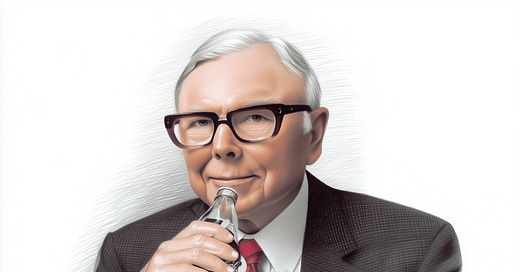How Munger’s Mental Models Outperformed Wall Street’s Algorithms
Learn the thinking system behind Berkshire’s legendary Apple and Coke bets.
👋 CMQ Investors,
Charlie Munger's multidisciplinary approach allowed Berkshire Hathaway to confidently make billion-dollar bets on Coca-Cola and Apple—two of the most successful investments in history.
This post is inspired by Episode #003 of the CMQ Investing podcast. Creating this episode in 2021 helped me understand Charlie Munger’s multidisciplinary thinking system on a much deeper level. I hope it does the same for you.
👉 Want to hear the episode before you read this post? Listen for free on Spotify, Apple Podcasts, or using the YouTube player below.🎙 Episode Summary:
“The Multiple Mental Models Approach To Investing” dives deep into the thinking system that gave Berkshire Hathaway a sustainable competitive advantage for decades: Charlie Munger’s multidisciplinary approach to decision-making.
Rather than just rehashing Munger’s ideas, the episode connects his mental models to two of the most legendary investment decisions in Berkshire’s history—Coca-Cola and Apple—revealing how this system enabled Berkshire to consistently outperform in a world of increasingly smart, computerized investors.
🧠 The Core Idea:
The true edge isn’t raw intelligence, but the ability to see what others can’t because you’re looking through more lenses than they are.
Since other investors may be smart, well-informed and highly computerized, you must find an edge they don’t have. You must think of something they haven’t thought of, see things they miss or bring insight they don’t possess.
—Howard Marks
That’s exactly what Charlie Munger did through his multidisciplinary approach, a thinking framework he adopted in law school and applied relentlessly in life and business.
📚 Origin of the Munger System:
Law School Moment: Munger rejected the notion that complex things could be understood in isolation. This realization set him on a lifelong mission to learn the "big ideas from the big disciplines."
Psychology First: He began with psychology, uncovering that powerful effects often emerge when multiple forces align—a phenomenon he termed the Lollapalooza Effect.
Mental Models: Instead of memorizing facts, Munger advocated building a latticework of mental models drawn from diverse disciplines—psychology, economics, physics, engineering, biology, etc.
🔁 Shift in Berkshire's Strategy:
Pre-Munger: Warren Buffett focused on buying "fair businesses at wonderful prices" (a.k.a. cigar-butt investing).
Post-Munger: Munger persuaded Buffett to pivot toward buying "wonderful businesses at fair prices"—a scalable approach as Berkshire's capital grew.
“Charlie’s most important architectural feat was the design of today’s Berkshire.”
— Warren Buffett, 2014 Shareholder Letter
📈 Join 5,400+ rational investors who get smarter each week with the free CMQ Investing newsletter.
🥤 Case Study #1: Coca-Cola
Context: After the 1987 crash, Coke stock became attractive.
Decision: Berkshire invested $1B (6.2% of the company), which became their largest holding.
Munger's Role: The multidisciplinary model revealed Coca-Cola as more than just a beverage company—it was a brand with deep psychological impact, global reach, and customer habit reinforcement (Lollapalooza Effect).
Results: By 1991, their Coke position alone was worth more than Berkshire's entire net worth just three years prior.
🍎 Case Study #2: Apple
Context: Nearly 30 years after Coca-Cola, Berkshire faced an even tougher investment landscape.
Decision: Bought 10M shares in 2016. Apple became Berkshire’s largest position, just like Coke once was.
Insight: Again, a simple business when stripped to its psychological and behavioral fundamentals. Apple, like Coke, had powerful user lock-in, ecosystem effects, and brand loyalty (another Lollapalooza Effect).
Munger’s View: In 2018, he lamented not buying more: "I wish we owned more of it."
🧩 Why It Worked: The Lollapalooza Effect
Munger defined the Lollapalooza Effect as the rare but powerful outcome when multiple psychological and business forces combine in the same direction.
Coca-Cola and Apple both exhibited:
Brand loyalty
Habit formation
Global scale
Network effects (Apple)
Scarcity of alternatives
Social proof
This confluence made them predictable and, in Munger's view, as close to a “sure thing” as one could find in investing.
💡 Key Takeaways:
Mental Models Work: Munger’s system isn't theory—it’s been battle-tested at billion-dollar scale.
Few Big Bets Matter: Buffett and Munger decided they didn’t need 100 great ideas—just one or two a year.
Think Differently: In a crowded, data-driven market, edge comes from how you think, not just what you know.
Practice, Not Just Know: Munger spent a lifetime practicing this thinking system—it’s not about shortcuts, but about sustained mental discipline.
🧵 Final Thought:
“It’s made life more fun. It’s made me more constructive. It’s made me more helpful to others. It’s made me enormously rich.”
— Charlie Munger on the multidisciplinary approach
The Charlie Munger system isn’t just for investing. It’s a lifelong method for solving hard problems, predicting outcomes, and making better decisions. Whether you're managing capital or just navigating life, it’s a model worth adopting—and practicing.
Want me to make more visuals like this? Let me know by tapping ❤️ below.
📚 Want more timeless wisdom about investing, delivered to your inbox? Join 5,400+ rational investors and become a free subscriber.
👋 Was this your first time here? Read my most popular public posts on Substack.




